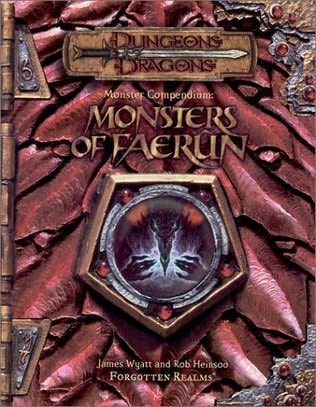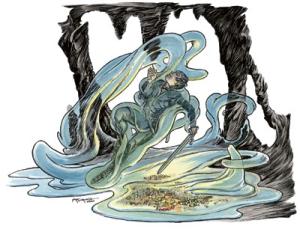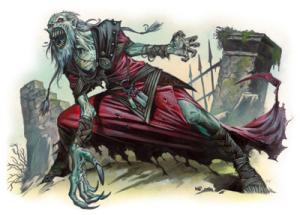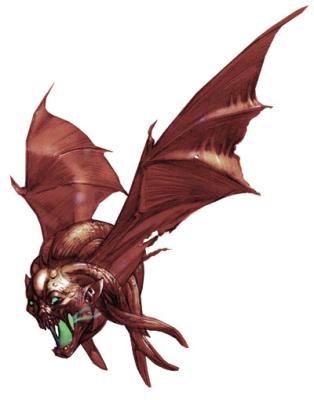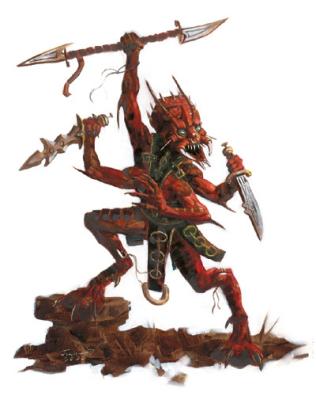More Forgotten Realms goodness:
The Chosen One is essentially a ghoul who causes temporary Constitution damage instead of paralysis. It doesn’t say why it is named that way, and only that chosen ones are made by the Red Wizards of Thay as servants. Very weak entry. (Variant Ghoul +1)
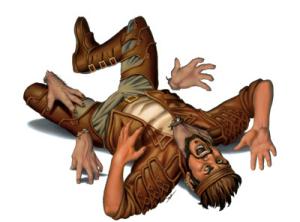
Crawling Claws, on the other hand, are awesome. They also are the other hand, as they are created only from left hands taken from dead or even living humanoids. They don’t have any special abilities or fancyful backstory. They are just animated hands that crawl around and attack people, which is cool and fun enough by itself. Creating one is only a 3rd level spell and each claw is automatically under the command of its creator. For some reason the spell is also evil, even though nothing about it indicates why. Ah well, alignment! Never made any sense, never will.
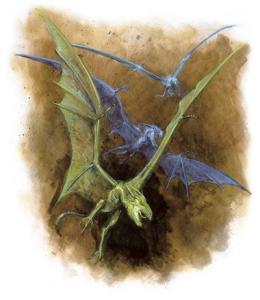
I am not sure where the idea of monsters being the creation of crazy wizards comes from, but it might very well have been Forgotten Realms. Darkenbeasts are somewhat reptilian and bat like monsters created from ordinary small animals by the Red Wizards. As their name hints at, darkenbeasts can not tollerate sunlight and after each ten minutes of exposure there is a 25% chance that the magic will end and the monster return back into an animal. In addition to being winged servants with a high resistance to magic, a wizard can also use a darkenbeast to store a spell for later. When the darkenbeast is near its master, he can retrieve the spell and aim it at whatever target he pleases, which destroyes the darkenbeast in the process. I think these are cooler than winged monkeys.
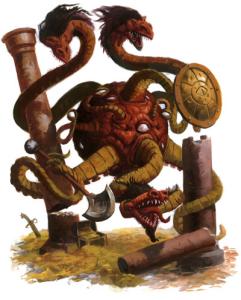
The Deepspawn had the potential to be one of the truly iconic weird monsters of Dungeons & Dragons, but somehow it remained limited to Forgotten Realms and didn’t really make any appearance after 2nd edtition. It’s on the cover of Lost Empires of Faerûn, but I think that’s it. When I first got into D&D with the Forgotten Realms campaign setting box (the 3rd edition FRCS had not been released yet), I thought that this creature was the fourth member of the exclusive group of aboleths, beholders, and illithids. But no it’s not, which is a shame. The deepspawn is a monster with a large spherical body over 5 meters in diameter and has six long tentacles. Three of the tentacles are used as arms, while the other three end in large maws full of sharp teeth. Its eyes are all over the body. The deepspawn by itself is not a terribly dangerous fighter and has only little magic abilities that would make any difference in a fight, but is completely immune to any poison and has a high resistance to magic. Its main ability is to spawn copies of any kind of living creature it has eaten, which takes between 1 and 4 day for each spawn. As a result, a deepspawn is never encountered alone but always surrounded and protected by a considerable force of other monsters it created. While the spawning ability is a bit dubious to me, I really do like its appearance and the idea that something like that would be the mastermind of a dungeon that rules over all the lesser monsters. The deepspawn got updated in Lost Empires of Faerûn, since the stats here are pretty shoddy. Size got increased from Large to Huge (which for a 5 meter sphere with long tentacles seems more correct), Strength got increased from measly 19 to 29 and Charisma bumped up from 4 to 10, which makes much more sense for something with Intelligence and Wisdom of 17. Now that looks a lot meaner, like something of this appearance should. Continue reading “Fantasy Safari: Monsters of Faerûn (D&D 3rd ed.), Part 2”

